Every March, the college basketball world converges on “March Madness”—the most thrilling tournament in American sports. For three electrifying weeks, 68 men’s teams and 68 women’s teams compete in single-elimination brackets where one loss ends championship dreams and one transcendent performance creates lifetime legacies.
The NCAA Tournament produces basketball’s most memorable moments: Christian Laettner’s turnaround jumper, Carmelo Anthony’s freshman championship run, Diana Taurasi’s triple crown of titles, Kemba Walker’s improbable UConn championship, Kris Jenkins’ title-winning three-pointer, and Breanna Stewart’s four consecutive championships. These performances don’t just win games—they define careers and cement places in basketball immortality.
But how do we properly honor these tournament legends? How should universities celebrate players whose March Madness performances elevated entire programs? And what can schools learn from the greatest tournament performers about building championship cultures?
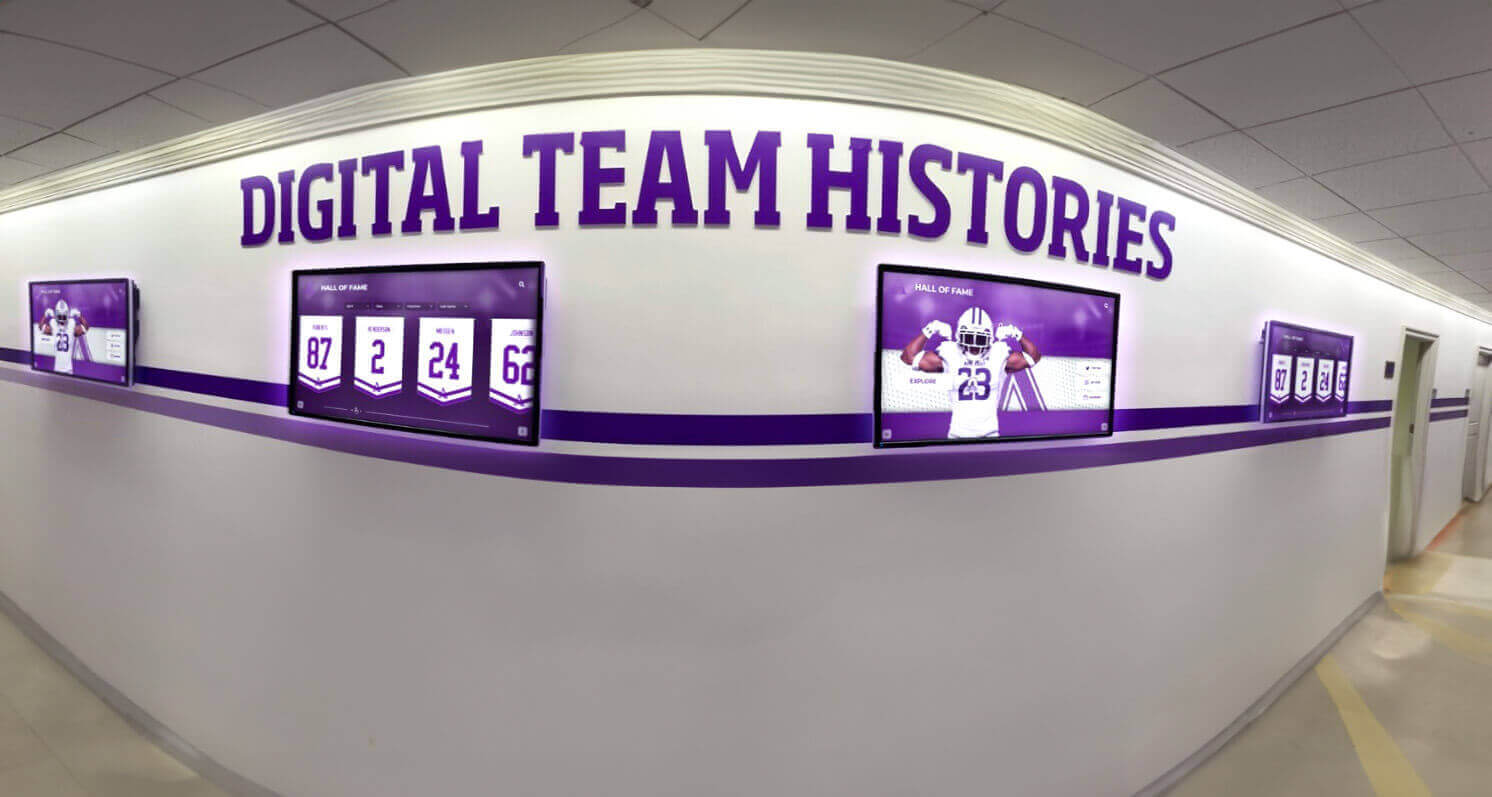
The Magic and Importance of March Madness
The NCAA Basketball Tournament holds unique significance in American sports culture, creating annual traditions that unite communities, spark passionate debates, and produce unforgettable athletic drama.
Why March Madness Matters
Cultural Phenomenon: March Madness transcends basketball fandom to become a national event. Millions of Americans fill out brackets predicting tournament outcomes, transforming casual observers into invested participants. Office pools, family competitions, and friendly wagers create shared experiences connecting people across demographic boundaries.
The Ultimate Meritocracy: Unlike professional sports where series extend across multiple games, March Madness operates on single-elimination stakes. Every possession matters. One exceptional performance or catastrophic mistake can define entire seasons. This format creates intensity unmatched in sports, where underdogs can shock favorites and unknown players can become overnight sensations.
Talent Showcase: The tournament provides basketball’s premier stage for young athletes. NBA scouts, media personalities, and millions of viewers watch closely as prospects perform under ultimate pressure. March Madness performances significantly impact draft positions, professional opportunities, and long-term earning potential—adding life-changing stakes to every game.
School Pride and Legacy: For universities, March Madness success transforms institutional identity. Schools earn “basketball school” reputations based on tournament achievements. Alumni connections strengthen around shared tournament memories. Application numbers increase following deep tournament runs. Championship banners hanging in arenas become permanent testaments to moments when programs reached their pinnacles.
The Pressure and Glory of Tournament Basketball
Tournament basketball demands unique mental fortitude distinguishing March Madness legends from regular season stars. The single-elimination format creates pressure unlike any regular season game:
No Tomorrow: Every tournament game potentially marks the season’s final contest. Athletes must perform at peak levels immediately, without opportunities to recover from poor performances or adjust strategies across game series.
Evolving Competition: Teams face different opponents each round—sometimes stylistic nightmares posing unfamiliar challenges. Players must adapt quickly to varying defensive schemes, offensive systems, and competitive intensities.
National Spotlight: Tournament games attract massive audiences and intense media scrutiny. Players accustomed to competing before modest crowds suddenly perform before millions. This spotlight amplifies both triumphant and disappointing moments.
Legacy Defining: College careers are ultimately remembered for March Madness performances. Regular season awards matter, but tournament success defines legacies. Players understand that tournament failures can overshadow entire careers while championship runs create permanent legendary status.
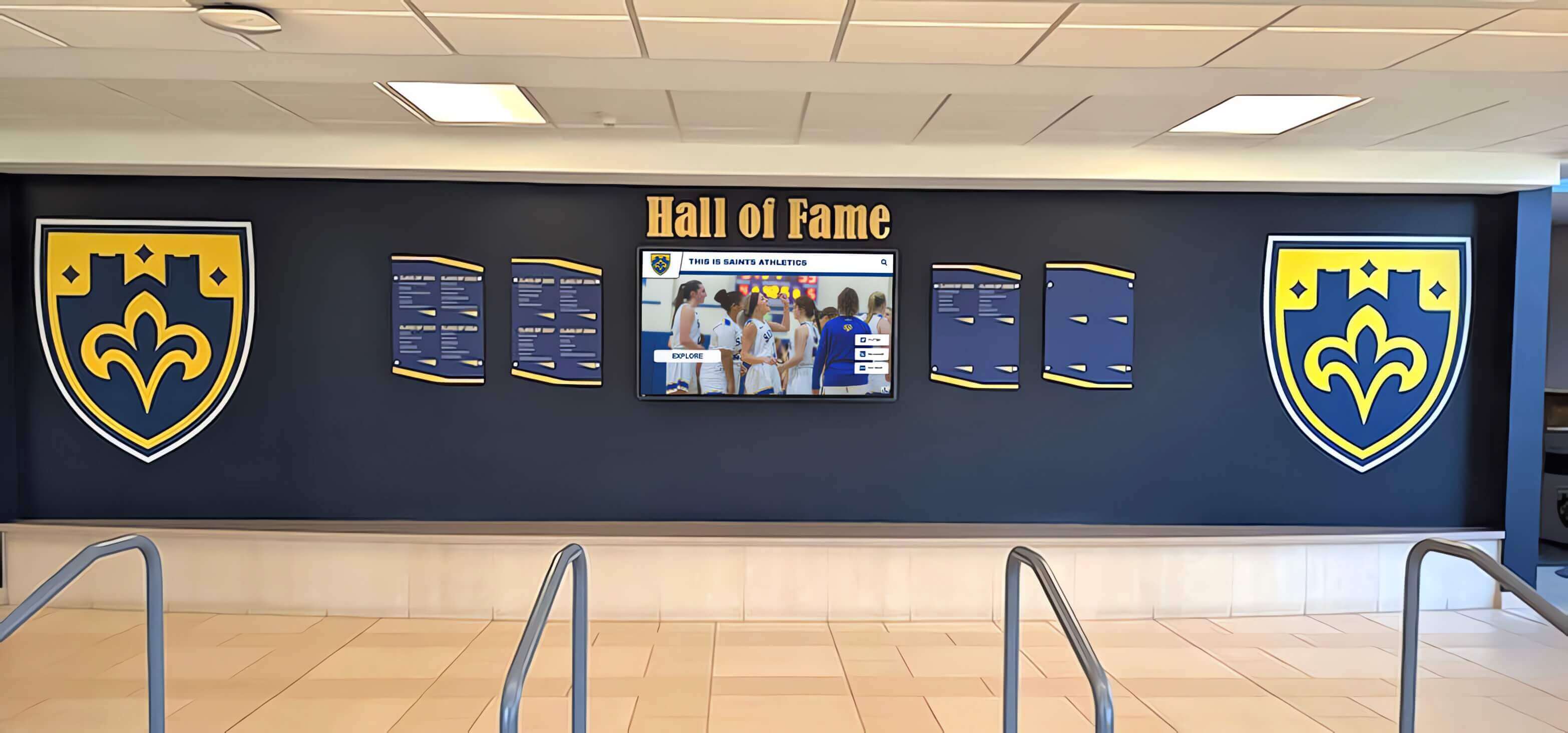
Greatest March Madness Performers: Men’s Tournament Legends
The men’s NCAA Tournament has produced countless legendary performances spanning decades. These players elevated their games when stakes reached their highest, leading teams to championships while creating unforgettable moments.
Championship Era Dominators
Bill Walton (UCLA, 1972-1974): Perhaps no player dominated March Madness more thoroughly than Bill Walton during UCLA’s dynasty years. Walton led the Bruins to two consecutive championships (1972, 1973) while establishing tournament performance standards rarely matched. His 1973 championship game performance against Memphis State remains legendary—21-of-22 shooting for 44 points, completely overwhelming the opposition. Walton combined size, skill, and basketball intelligence to create matchup nightmares opponents couldn’t solve. His tournament dominance helped UCLA maintain its dynasty, though his playing time in 1974 was limited by injury.
Christian Laettner (Duke, 1989-1992): If one player embodies March Madness excellence, Christian Laettner deserves consideration. Laettner’s perfect tournament record (21-2) and clutch performances in crucial moments defined Duke’s early 1990s championships. His 1992 Elite Eight performance against Kentucky—featuring the iconic last-second turnaround jumper—represents tournament basketball at its dramatic peak. Laettner finished with 407 career tournament points, demonstrating sustained excellence across four years. His two championships (1991, 1992) established Duke as basketball royalty while cementing Laettner’s status among tournament legends.
Magic Johnson (Michigan State, 1979): Though Magic Johnson’s college career spanned just two seasons, his tournament impact proved transformative. His 1979 championship game against Larry Bird and Indiana State became one of sports’ most-watched college games ever, launching the Magic-Bird rivalry that would define professional basketball’s next decade. Johnson averaged 17.0 points, 8.1 rebounds, and 7.8 assists per game in tournament play, showcasing the versatile playmaking ability that would characterize his Hall of Fame career.
Carmelo Anthony (Syracuse, 2003): Anthony’s freshman championship run ranks among tournament history’s most impressive individual performances. Leading Syracuse through a challenging bracket, Anthony averaged 20.1 points and 9.8 rebounds during the tournament. His combination of scoring versatility, rebounding tenacity, and clutch shot-making at age 18 demonstrated maturity beyond his years. The 2003 championship represented Syracuse’s first title, with Anthony’s dominant play proving decisive throughout the tournament run.
Cinderella Story Heroes
Kemba Walker (Connecticut, 2011): Walker’s 2011 tournament performance epitomizes March Madness magic. After struggling during parts of the regular season, Walker elevated his game when it mattered most, leading UConn through five consecutive victories to capture the Big East tournament before guiding the Huskies through the NCAA Tournament. Walker scored 130 points across UConn’s six tournament games, delivering clutch performances when elimination loomed. His combination of scoring ability, playmaking, and fearless mentality in pressure situations created one of tournament history’s most memorable championship runs.
Glen Rice (Michigan, 1989): Rice’s 1989 tournament performance set scoring records that stood for years. Rice averaged 30.7 points per game during Michigan’s championship run, including a 31-point outburst in the title game against Seton Hall. His 184 total tournament points in 1989 established an NCAA record demonstrating sustained scoring excellence across multiple games. Rice’s shooting touch and ability to create offense in critical moments powered Michigan to its first championship in over three decades.
Modern March Madness Stars
Shabazz Napier (Connecticut, 2014): Napier led Connecticut to its fourth national championship with spectacular tournament performances combining scoring, leadership, and clutch play. Named Most Outstanding Player after averaging 20.7 points during the tournament, Napier dominated both ends of the floor while delivering memorable quotes about hunger and determination that resonated nationally. His championship run came as UConn shocked higher-seeded opponents throughout the bracket.
Tyus Edney (UCLA, 1995): While UCLA’s 1995 championship team featured multiple contributors, Tyus Edney’s coast-to-coast game-winning layup against Missouri in the second round represents one of tournament history’s most iconic plays. Edney’s 4.8-second dash the length of the court, weaving through defenders before scoring as time expired, saved UCLA’s season and propelled the Bruins toward their 11th national championship. That single play exemplifies March Madness drama at its purest.

Greatest March Madness Performers: Women’s Tournament Icons
The women’s NCAA Tournament has created its own legendary performers whose dominance, skill, and championship pedigree match any accomplishments in basketball history.
Dynasty Builders
Diana Taurasi (Connecticut, 2001-2004): Taurasi stands as perhaps the greatest winner in college basketball history regardless of gender. Her three consecutive championships (2002-2004) established UConn as the women’s game’s premier program while showcasing Taurasi’s complete offensive arsenal. She averaged 19.9 points during her tournament career while demonstrating clutch gene qualities in pressure situations. Taurasi’s combination of scoring ability, basketball intelligence, and competitive fire set standards for excellence that influenced an entire generation of players.
Breanna Stewart (Connecticut, 2013-2016): Stewart accomplished the unprecedented—four consecutive national championships. Named Most Outstanding Player in all four Final Fours, Stewart demonstrated sustained excellence unmatched in modern college basketball. She averaged 18.9 points and 9.3 rebounds during her tournament career while dominating opponents with size, skill, and versatility few could match. Stewart’s perfect 24-0 tournament record represents one of sports’ most remarkable achievements, cementing her legacy among basketball’s all-time greats.
Maya Moore (Connecticut, 2008-2011): Moore’s two championships (2009, 2010) came during dominant tournament performances showcasing her complete game. Moore averaged 20.2 points and 8.0 rebounds during tournament play while earning two Most Outstanding Player awards. Her efficiency, defensive intensity, and ability to elevate teammates made her one of the most complete players women’s basketball has produced. Moore’s college success translated into professional dominance, with her UConn foundation preparing her for WNBA and international stardom.
Individual Brilliance
Chamique Holdsclaw (Tennessee, 1996-1999): Holdsclaw powered Tennessee to three consecutive championships (1996-1998) during Pat Summitt’s dynasty years. Her combination of size, athleticism, and skill created matchup problems opponents couldn’t solve. Holdsclaw averaged 19.5 points and 9.1 rebounds during tournament play, dominating both inside and on the perimeter. Her tournament performances helped establish Tennessee as women’s basketball’s premier program throughout the 1990s.
Cheryl Miller (USC, 1983-1986): Miller revolutionized women’s basketball while leading USC to consecutive championships in 1983 and 1984. Her athletic ability, competitive intensity, and all-around brilliance set new standards for women’s basketball excellence. Though detailed tournament statistics from this era aren’t as comprehensively documented as modern records, Miller’s impact on raising the women’s game’s profile cannot be overstated. Her tournament performances attracted unprecedented attention to women’s college basketball.
Candace Parker (Tennessee, 2006-2008): Parker became the first woman to dunk in an NCAA Tournament game while leading Tennessee to consecutive championships (2007-2008). Named Most Outstanding Player both years, Parker averaged 19.7 points and 10.6 rebounds during her tournament career. Her unique combination of size, athleticism, and skill demonstrated the evolving talent level in women’s basketball while maintaining Tennessee’s championship tradition following Summitt’s earlier dynasty.
Clutch Tournament Performers
Sue Bird (Connecticut, 2000-2002): Bird’s point guard mastery orchestrated Connecticut’s dominant championship runs in 2000 and 2002. Her ability to control tempo, deliver pinpoint passes, and make crucial decisions under pressure made her one of tournament history’s most valuable players despite not dominating scoring statistics. Bird’s 5.4 assists per game during tournament play demonstrated her facilitation skills while her leadership qualities helped UConn navigate pressure-packed situations.
Sabrina Ionescu (Oregon, 2016-2020): Though Ionescu never captured a championship, her tournament performances demonstrated excellence worthy of recognition. She averaged 18.2 points, 8.4 rebounds, and 7.8 assists during tournament games, showcasing the versatile brilliance that made her one of college basketball’s greatest players. Ionescu’s Final Four performances, though ending in defeats, highlighted her ability to elevate her game on the biggest stages.

Memorable March Madness Moments That Define Tournament History
Beyond individual career achievements, single moments and performances have created March Madness mythology that transcends basketball itself.
Buzzer-Beaters and Game-Winners
Kris Jenkins (Villanova, 2016): Jenkins’ three-pointer at the buzzer to defeat North Carolina in the 2016 championship game represents one of sports’ most dramatic finishes. The play—a perfectly executed possession culminating in Jenkins’ confident shot—gave Villanova its second national championship while creating an iconic moment replayed endlessly during every subsequent March. The celebration’s pure joy captured March Madness magic at its essence.
Lorenzo Charles (N.C. State, 1983): Charles’ dunk of Dereck Whittenburg’s desperation shot at the buzzer to defeat Houston in the 1983 championship represents one of tournament history’s most improbable endings. N.C. State, led by coach Jim Valvano, entered the tournament as a heavy underdog but caught fire during March. Charles’ putback created the image of Valvano racing across the court seeking someone to embrace—a moment symbolizing March Madness’s unpredictability and emotion.
Christian Laettner’s “The Shot” (Duke, 1992): Already mentioned among career achievements, Laettner’s turnaround jumper deserves specific recognition. With 2.1 seconds remaining in overtime, Laettner caught Grant Hill’s perfect three-quarter court pass, dribbled once, turned, and swished the game-winner to eliminate Kentucky. The shot’s technical difficulty, pressure situation, and dramatic stakes make it arguably the greatest play in tournament history.
Underdog Triumphs
UMBC over Virginia (2018): The first-ever 16-seed victory over a 1-seed shocked the basketball world. UMBC’s 20-point demolition of top-seeded Virginia didn’t just represent a narrow upset—it completely dominated a team that had entered the tournament as the overwhelming favorite. This historic victory demonstrated that March Madness truly offers opportunities for any team to achieve the improbable when performance peaks at the right moment.
George Mason’s Final Four Run (2006): The 11-seed Patriots defeated Michigan State, North Carolina, and Connecticut—all higher-seeded, more prestigious programs—to reach the Final Four. Coach Jim Larranaga’s team embodied March Madness spirit, proving that exceptional coaching, team chemistry, and timely performances could overcome talent disparities. George Mason’s run inspired mid-major programs nationwide while captivating neutral fans.
NC State’s Improbable Championship (1983): Jim Valvano’s Wolfpack won nine elimination games—including five in the ACC Tournament just to reach the NCAA field—before capturing the national championship. Their defeat of Houston’s “Phi Slama Jama” featuring Hakeem Olajuwon and Clyde Drexler represented a complete underdog triumph. Valvano’s emotional celebration has become tournament history’s most iconic image.
How Schools Celebrate March Madness Excellence
Universities recognize tournament achievements through various methods honoring players whose March performances elevated entire programs.
Traditional Recognition Approaches
Championship Banners: Hanging championship banners in arena rafters represents the most visible recognition method. These permanent reminders of tournament success become focal points for fans, creating visible connections to program glory. Digital banner recognition systems provide modern alternatives that showcase comprehensive championship histories.
Retired Jerseys: Permanently retiring numbers of legendary tournament performers honors their contributions while ensuring future players understand the standards set by predecessors. This selective honor typically reserves itself for the most exceptional performers whose achievements transcend statistics.
Trophy Cases: Physical trophy cases displaying championship hardware, individual awards, and tournament memorabilia create tangible connections to historic achievements. However, space limitations force difficult decisions about which accomplishments receive prominent display versus storage.
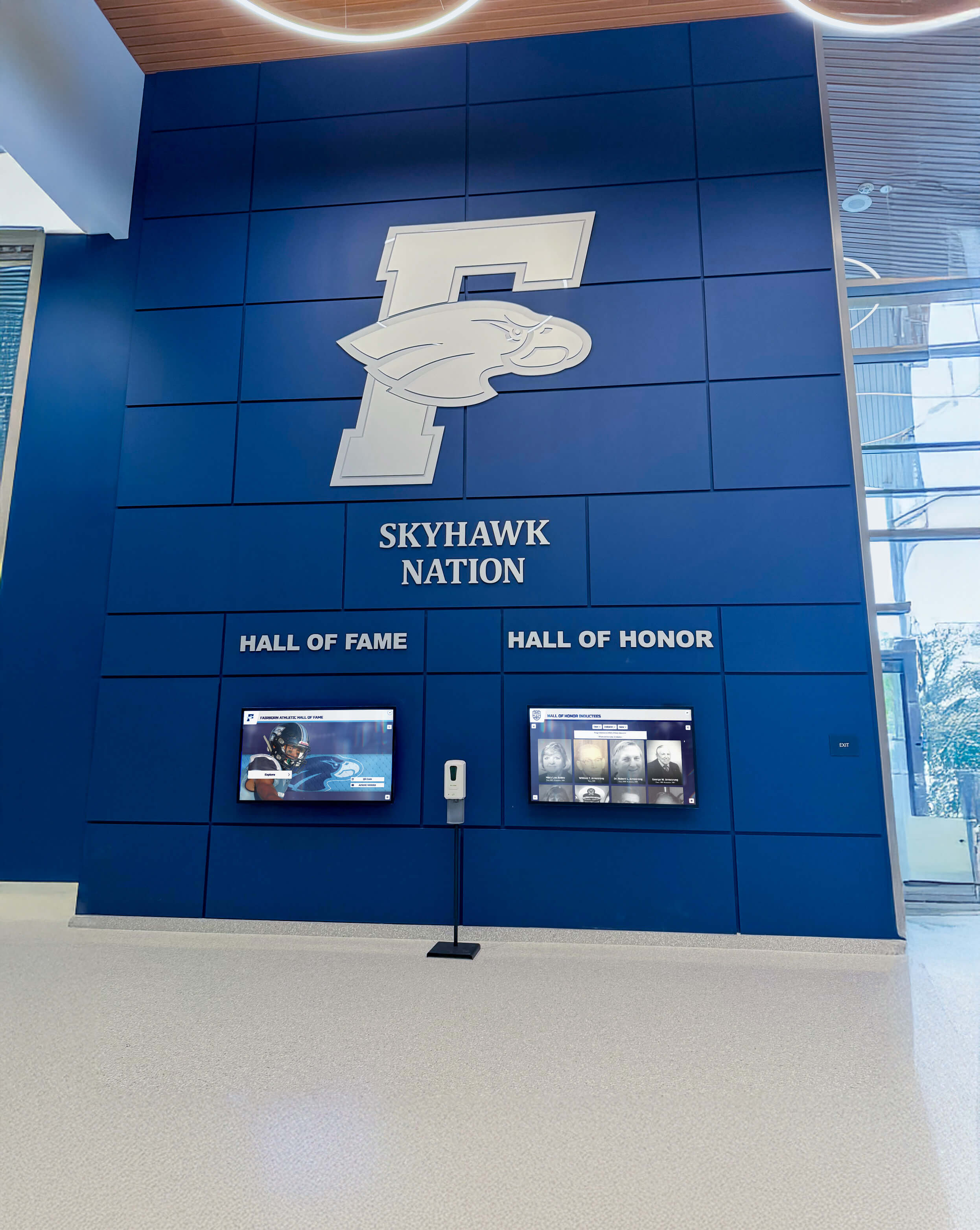
Modern Digital Recognition Solutions
Digital recognition displays solve traditional display limitations while creating engaging experiences celebrating tournament excellence:
Unlimited Capacity: Digital systems recognize every significant tournament performer throughout program history without space constraints limiting who receives acknowledgment.
Multimedia Storytelling: Video highlights of tournament performances, player interviews, game recaps, and statistical deep dives bring March Madness achievements to life in ways static plaques cannot match. Fans can watch championship game highlights, hear players describe pressure moments, and experience tournament runs comprehensively.
Interactive Exploration: Touchscreen interfaces allow visitors to search by year, opponent, performance statistics, or player name. Alumni returning to campus can instantly locate their tournament contributions while recruits explore the program’s March Madness tradition.
Real-Time Updates: When teams advance through tournaments, digital displays can be updated immediately to celebrate current achievements alongside historical successes. This capability maintains relevance while connecting present performances to past excellence.
Comprehensive Statistics: Digital record boards document tournament statistics across categories impossible to display through traditional methods—single-game scoring leaders, career tournament points, championship game performances, and more.
Schools implementing comprehensive digital recognition report enhanced recruit interest, stronger alumni engagement, and increased visibility for tournament achievements that might otherwise fade from collective memory.
Creating Basketball Hall of Fame Experiences
Universities establish dedicated athletic halls of fame celebrating tournament performers alongside career achievement honorees:
Selection Criteria: Programs establish clear standards determining hall of fame eligibility—typically including tournament success among evaluation factors. All-American selections, conference championships, and regular season records matter, but March Madness performances often prove decisive for borderline candidates.
Induction Ceremonies: Annual induction events bring former players back to campus, strengthening alumni connections while celebrating new honorees. These ceremonies often coincide with high-profile games, maximizing attendance and visibility.
Permanent Recognition: Whether through traditional plaques or digital displays, hall of fame recognition ensures legendary tournament performers receive lasting acknowledgment matching their contributions. Solutions like Rocket Alumni Solutions provide comprehensive platforms specifically designed for athletic recognition, enabling schools to honor achievements properly.
The Psychology of Tournament Excellence
Understanding what separates March Madness legends from typical players reveals lessons applicable beyond basketball.
Mental Attributes of Tournament Stars
Composure Under Pressure: Tournament legends consistently demonstrate remarkable calmness in high-stakes situations. While other players tighten up as pressure mounts, legends maintain their mechanics, make sound decisions, and trust their preparation. This mental strength often proves more decisive than physical talent.
Moment Recognition: Great tournament performers understand when to assert themselves versus when to defer to teammates. They recognize crucial possessions requiring their involvement and moments when facilitating teammates creates better outcomes. This basketball intelligence separates good players from legendary ones.
Short-Term Memory: Tournament basketball requires quickly forgetting mistakes and moving forward. Players who dwell on missed shots or defensive breakdowns compound errors through distraction. Legends maintain focus on the next possession regardless of previous outcomes.
Confidence Without Arrogance: Tournament stars believe in their abilities while remaining coachable and team-oriented. They accept coaching criticism, acknowledge teammate contributions, and maintain humility despite their success. This balance creates both individual excellence and team chemistry.
Team Chemistry in Tournament Success
While individual stars receive recognition, championship teams consistently demonstrate exceptional chemistry and collective commitment:
Role Acceptance: Tournament champions feature players embracing specific roles—whether scoring leaders, defensive specialists, rebounders, or playmakers. When teammates accept their responsibilities without ego conflicts, teams maximize collective talent.
Defensive Identity: Championship teams typically excel defensively, particularly during tournament play when offensive execution often becomes difficult. Teams commit to defensive principles and effort regardless of offensive struggles.
Veteran Leadership: Tournament success frequently correlates with experienced players who’ve navigated previous March Madness pressure. These veterans help younger teammates manage emotions, maintain focus, and execute under stress.
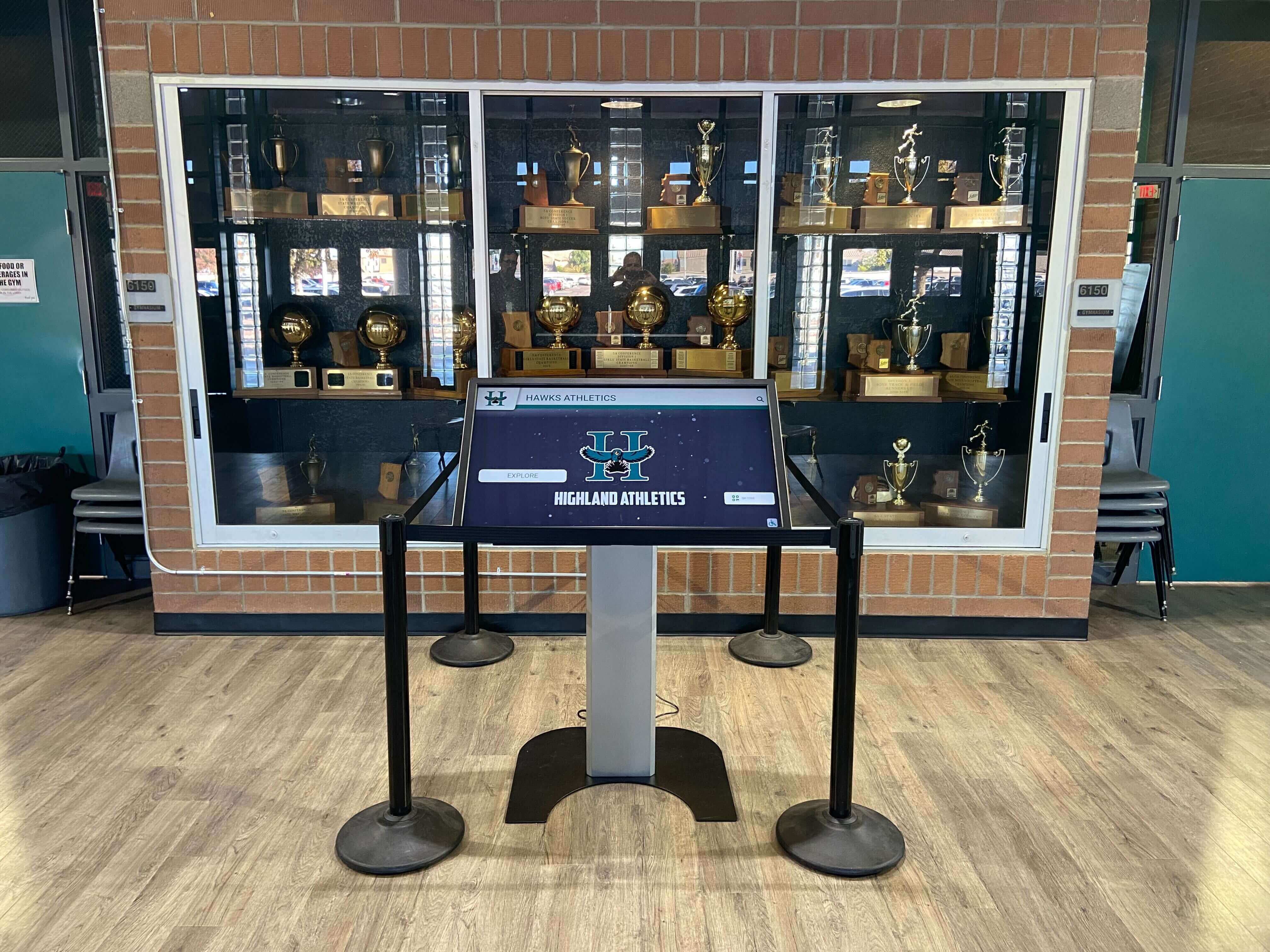
Building Championship Culture Through Recognition
How schools celebrate past tournament success significantly influences current player motivation and program culture.
The Power of Visible Excellence
Daily Inspiration: When current players pass recognition displays celebrating past tournament legends, they receive constant reminders of program standards and achievable excellence. This ambient motivation reinforces that championship success represents realistic goals rather than distant fantasies.
Recruiting Advantage: Comprehensive recognition demonstrates to recruits that programs value and permanently honor exceptional achievement. Prospects envision themselves joining honored alumni in recognition displays, creating aspirational motivation influencing commitment decisions.
Cultural Continuity: Recognition maintains institutional memory across coaching changes and personnel turnover. Current teams understand they’re part of traditions extending decades, connecting them to program legacies and creating responsibility to maintain standards.
Inspiring Current Athletes
Modern recognition approaches enhance motivational impact through strategic implementation:
Goal-Setting Integration: Programs tracking statistical achievements help players understand paths toward recognition. When athletes know exactly what performance levels earn acknowledgment, they pursue those benchmarks systematically.
Mentorship Connections: Recognition platforms featuring contact information or video messages from alumni create mentorship opportunities. Current players can connect with former stars who’ve navigated similar pressures and challenges.
Year-by-Year Progression: Showing how players developed across multiple seasons provides roadmaps for improvement. Freshmen see that many legends struggled early before developing into stars—providing patience and persistence motivation.
Implementing Comprehensive Basketball Recognition Programs
Schools establishing or enhancing basketball recognition should follow systematic approaches maximizing effectiveness.
Assessment and Planning
Historical Documentation: Comprehensive recognition begins with researching program history, compiling tournament results, documenting significant performances, and collecting photos and media coverage. This foundation ensures complete representation of program achievements.
Stakeholder Input: Gathering perspectives from coaches, former players, athletic administrators, and alumni ensures recognition approaches address actual community values rather than assumed preferences.
Technology Selection: Choosing between traditional displays, digital systems, or hybrid approaches depends on budget, available space, technical infrastructure, and strategic priorities. Hardware selection guides help navigate options effectively.
Content Development
Profile Creation: Developing comprehensive athlete profiles requires biographical research, statistical compilation, photo and video collection, and narrative writing capturing both achievements and character. Quality content distinguishes inspiring recognition from basic acknowledgment.
Tournament Documentation: Creating detailed tournament run documentation—game-by-game results, statistical leaders, key moments, and championship celebrations—preserves complete stories rather than simply noting final outcomes.
Multimedia Production: Video editing, photo curation, and interview recording create engaging content bringing achievements to life. Creating engaging video content enhances visitor engagement significantly.
Ongoing Management
Regular Updates: Adding new tournament performers, updating alumni accomplishments, and refreshing featured content maintains relevance and gives visitors reasons to return repeatedly.
Promotion and Awareness: Marketing recognition programs through social media, campus tours, game-day presentations, and alumni communications maximizes visibility and engagement.
Analytics and Improvement: Tracking visitor engagement, gathering feedback, and monitoring recognition program impact enables continuous enhancement ensuring sustained effectiveness.
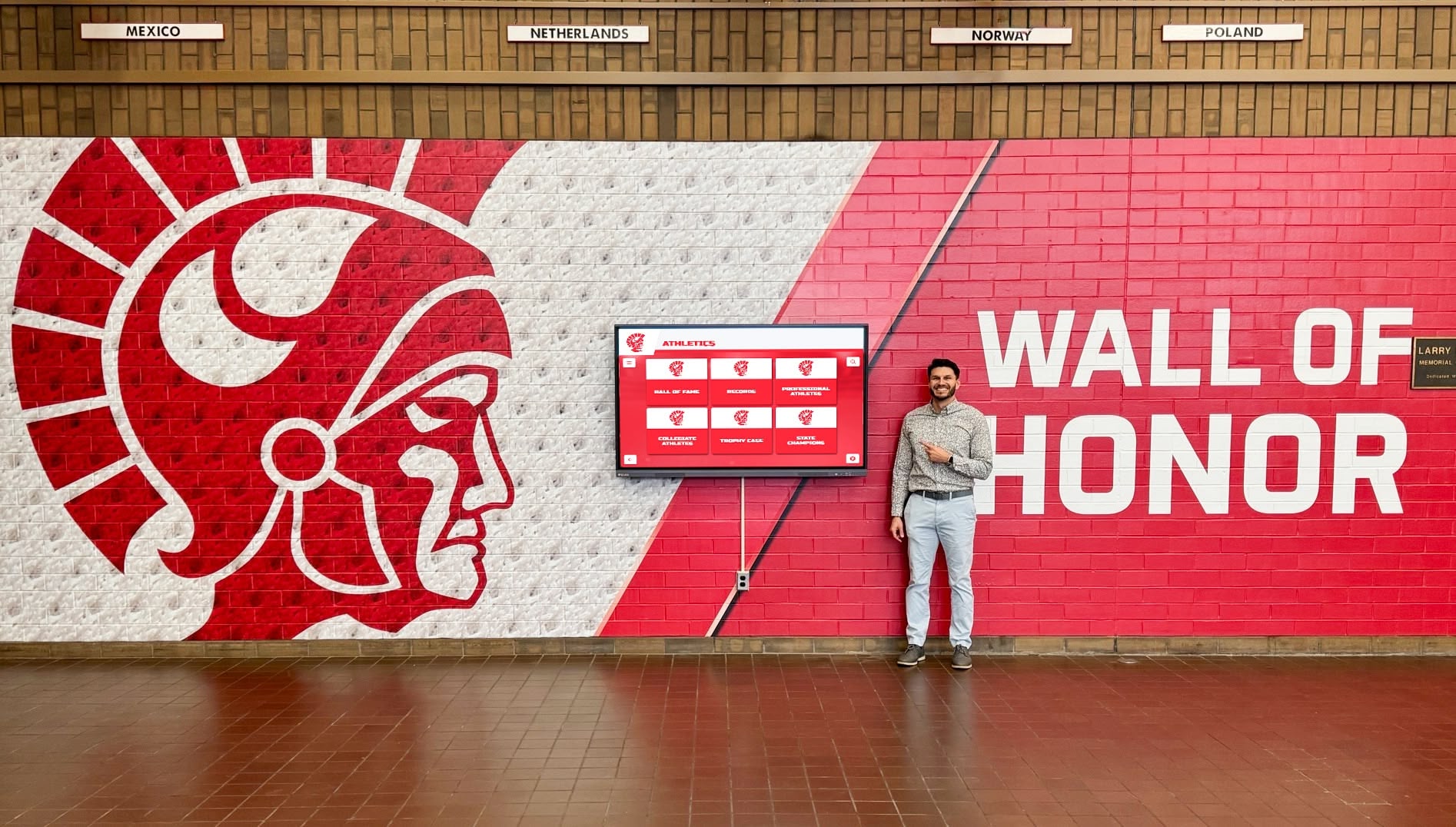
The Future of March Madness Recognition
Technology continues evolving, creating new possibilities for celebrating tournament excellence.
Emerging Recognition Technologies
Augmented Reality: AR capabilities will enable mobile users to access additional content layers when viewing physical displays—watching game highlights by pointing phones at player photos or exploring statistical deep dives through AR interfaces.
Artificial Intelligence: AI-powered highlights will automatically generate compelling video compilations from game footage, dramatically reducing video production effort while ensuring comprehensive coverage of tournament moments.
Social Integration: Future systems will facilitate alumni contribution of personal memories, photos, and stories—creating community-driven recognition that supplements official content with personal perspectives.
Personalization: Recognition displays will adapt content based on viewer characteristics—highlighting relevant players, eras, or achievements based on user preferences or demographics.
Virtual and Remote Access
Global Engagement: Web-based recognition platforms enable alumni worldwide to explore program achievements regardless of geographic distance from campus. This accessibility particularly matters for international players who may return to home countries after graduation.
Interactive Statistics: Advanced data visualizations will help visitors understand performance context—comparing tournament achievements across eras, showing performance trends, and contextualizing individual accomplishments within program and national historical frameworks.
Conclusion: Honoring March Madness Excellence
March Madness creates basketball’s most magical moments—where underdogs defeat favorites, unknown players become legends overnight, and pressure-packed performances define careers. From Christian Laettner’s perfect tournament shooting to Breanna Stewart’s unprecedented four championships, tournament excellence deserves recognition matching its significance.
Modern recognition solutions enable schools to comprehensively celebrate tournament heroes while creating engaging experiences that inspire current athletes, strengthen alumni connections, and preserve program legacies. Whether through traditional championship banners or interactive digital displays, effective recognition ensures that March Madness legends receive lasting acknowledgment worthy of their contributions.
For programs seeking to honor tournament excellence while building championship cultures, solutions like Rocket Alumni Solutions provide comprehensive platforms specifically designed for athletic recognition. These systems combine unlimited recognition capacity with engaging multimedia storytelling and intuitive interaction—transforming how schools celebrate the players and moments that defined their programs’ greatest achievements.
Every March, new legends emerge on college basketball’s biggest stage. Ensuring those legends receive proper recognition honors the past while inspiring future generations to pursue their own tournament glory. From first-round upsets to championship celebrations, March Madness excellence deserves permanent commemoration matching the moments’ significance and impact.
Ready to celebrate your program’s tournament heroes? Modern basketball recognition displays provide comprehensive solutions honoring March Madness excellence while building traditions that inspire championship pursuits for generations to come.




































